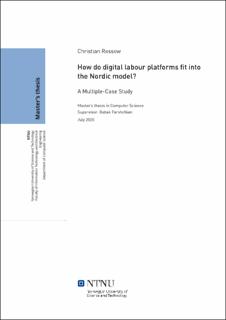| dc.contributor.advisor | Farshchian, Babak | |
| dc.contributor.author | Rossow, Christian | |
| dc.date.accessioned | 2021-09-15T16:16:50Z | |
| dc.date.available | 2021-09-15T16:16:50Z | |
| dc.date.issued | 2020 | |
| dc.identifier | no.ntnu:inspera:57320302:25710582 | |
| dc.identifier.uri | https://hdl.handle.net/11250/2777875 | |
| dc.description.abstract | I løpet av det siste tiåret har nye digitale arbeidsplattformer dukket opp og forårsaket disruptive endringer forskjellige industrier og markeder jorden rundt. Disse plattformene endrer seg stadig vekk og ekspanderer kjapt til nye markeder. Felles for de fleste av disse plattformene er ansettelsesformen med løst tilknyttede arbeidere på plattformen. Dette er noe som ikke går helt hånd i hanske med den nordiske modellen. Denne studien presenterer derfor forskningsspørsmålet, «hvordan passer digitale arbeidsplattformer inn i den nordiske modellen?» sammen med tre del-spørsmål.
Masteroppgaven presenterer resultatene ved hjelp av en systematisk litteraturgjennomgang og en case studie med flere firmaer. Studien starter med en grundig gjennomgang av nødvendig teori om digitale arbeidsplattformer og den nordiske modellen. Studien presenterer også en state of the art av den relevante litteraturen for teamet i oppgaven. De tre plattformene som inngår i case studien er Foodora, Wolt og Vaskehjelp.no. Funnene i case studien belyser de forskjellige teknologiske verktøyene hver plattform bruker, samt ansettelsesformen og lønnen til arbeiderne på plattformen. Forfatteren av denne oppgaven hevder avslutningsvis at ingen av plattformene i casestudien passer helt inn i den nordiske modellen, men det er muligheter for Foodora-plattformen kan oppnå det på sikt. | |
| dc.description.abstract | Over the last decade have new digital labour platforms emerged and caused a disruptive change in different industries and markets all around the world. These platforms are rapidly changing and expanding into new markets. Common for most of these platforms is the loosely coupled employment form of workers on the platforms. This is something that doesn't go to well with the Nordic model. The thesis, therefore, presents the research question; "How do digital labour platforms fit into the Nordic model?" along with three sub-questions.
The thesis presents the results using a systematic literature review and a multiple-case study, starting with a thorough background theory on digital labour platforms and the Nordic model, as well as the relevant literature as state of the art. The three platforms Foodora, Wolt and Vaskehjelp.no, were chosen for the case study. The findings of the case study highlight the different technological affordances each platform use, as well as detailing the employment form and salaries of the workers on the platform. The author of this thesis argues that none of the platforms in the case study fit entirely into the Nordic model, but there are possibilities for the Foodora platform to achieve this. | |
| dc.language | | |
| dc.publisher | NTNU | |
| dc.title | How do digital labour platforms fit into
the Nordic model? | |
| dc.type | Master thesis | |
